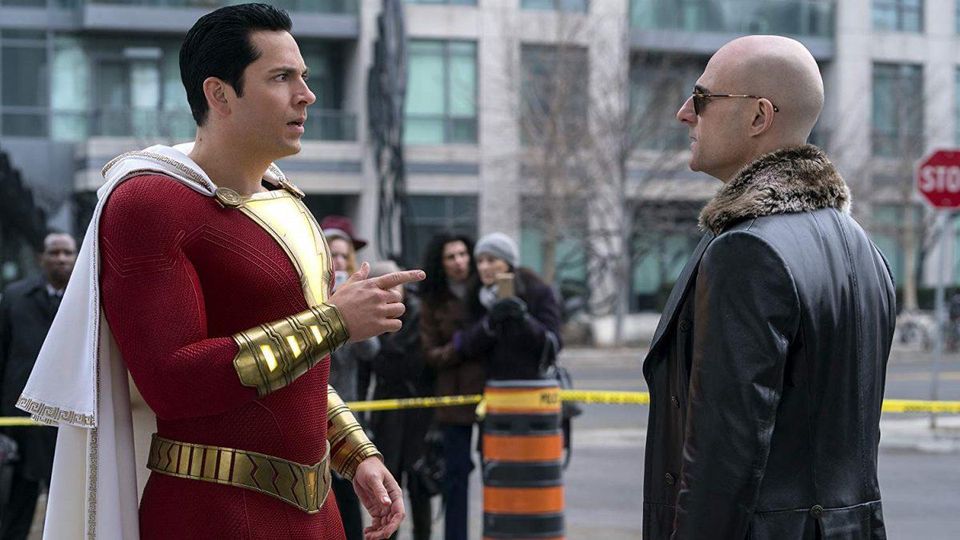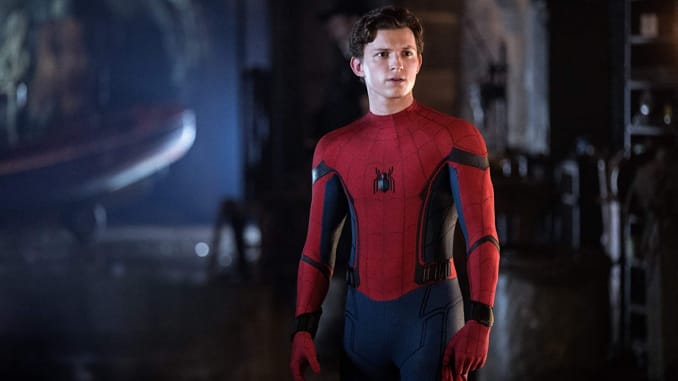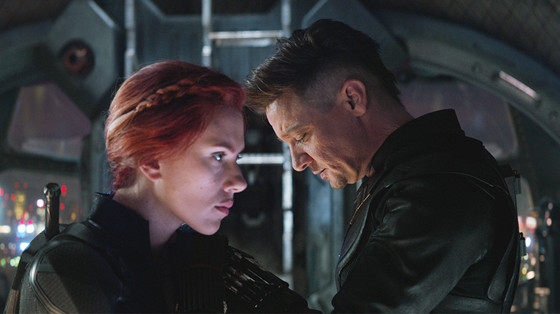5. Shazam

Easily the best from the DC Extended Universe! “Shazam” isn’t a great movie, but it’s a bombastically delightful and fun one. It’s a Christmas family special, paranormal action flick, hammy revenge feature, and superhero parody all gift-wrapped into one. It’s a shame it wasn’t released during Christmas, because the holiday atmosphere adds to the well-crafted warmth of the film.
“Shazam” follows bad boy foster child Billy Batson, who’s obsessed with finding his biological mother. He gets transferred to a loving foster home that he doesn’t particularly appreciate, and because of a stroke of luck, is transported to another realm where an ancient wizard gives him superpowers to save the world from the seven deadly sins. And the superpowers come with the catch – Billy must take on an adult body in the process. This bonkers premise gives a charming set of whimsical escapades that follow. Billy and his foster brother Freddy are believable characters who behave like how most kids would act if suddenly given superpowers.
“Shazam” is probably at its most charming when delving into the in universe mechanics of a superhero world. Freddie collects superhero wreckage, like how real superhero fans in our world collect superhero action figures. Billy first uses his Shazam persona to become a charlatan superhero social media personality, much like how today’s modern faith healers garner large online followings.
But what completes “Shazam” is its heartwarming themes of how family transcends blood and relation. With its wonderfully hammy villain, lovely themes of family, and fun and charismatic performances from the whole cast (especially Zachary Levi and Jack Dylan Grazer), “Shazam” is a great film to watch in any situation in desperate need of fun (aka: the DCEU). It’s a superpowered sentimental hallmark movie done right.
4. Spider-Man: Far From Home

“Spider-Man: Far From Home” definitely couldn’t top the scale of the MCU’s summer spectacle “Avengers: Endgame,” and fortunately it didn’t try to. It’s a down-to-earth comedy that feels more like a two hour Marvel one-shot than an actual movie, but that’s what makes it so fun. “Far From Home” continues the MCU narrative through the eyes of Peter Parker, who is fatigued from all the bam and ka-pow of the superhero fare, wanting to relax and live the good life of the classic teenage American summer vacation. In other words, making out with his crush, MJ.
But it turns out you don’t choose the superhero life, the superhero life chooses you, and Peter Parker finds himself donning the Spider-Man suit once more on a mission to defeat the Elementals: mythological, earth-shattering creatures from an alternate reality. But everything isn’t as it seems, and Spider-Man finds himself on an action trip of smoke and mirrors.
The marketing campaign for “Far From Home” was extremely clever. When trailers first dropped, fans complained they revealed too much, but as Jake Gyllenhaal’s Quentin Beck (aka: Mysterio) says in the film, “It’s easy to full people when they’re already fooling themselves.” We only saw what they wanted us to see. The film’s twists were genuinely surprising: Mysterio’s alternate-dimension story was a facade. Instead he’s a techno-wizard holograph illusionist trying to trick everyone into thinking he’s the greatest hero in the world, and this plot thread gives us Gyllenhaal’s funniest performance to date. He’s no average MCU villain – he’s an unempathetic, despicable dirtbag, yet we still enjoy watching him! Because deep down, he’s a director at heart.
Many of the film’s most enjoyable scenes are of Beck orchestrating his grand illusion as he commands his crew to get his scenes right. Unfortunately, Beck’s film is set in the real world, and as he amps up the destruction, more people are destined to die on Mysterio’s behalf. What follows is a web of fun ‘Spider-Man around the world’ moments and inventive, pop-surrealist action scenes.
The main plot is smart and engaging, and the subplots are equally so. Tom Holland is, as usual, great as a 21st century highschool Spider-Man, and his summer romance with Zendaya’s MJ is a nice contrast to the CGI superhero business. Peter Parker’s friend Ned is as hilarious as he was in “Spider-Man: Homecoming,” although this time around he seemed to be a bit more of a caricature than his more grounded, former self.
Overall, “Far From Home” is this high up the list because it outcharms the other super-flicks on this list. From the low-fi PowerPoint opening to the stop-motion end credits animated entirely with school supplies, this Marvel outing is a cute pastiche of school, summer, and Spider-Man. You’ll walk out of this movie with a smile on your face.
3. The LEGO Movie 2: The Second Part

Is this really a superhero movie, and if so, why is it ranked so high? Given that “The LEGO Movie 2: The Second Part” is a parody of our current blockbuster climate (with Batman and the Justice League being featured in it) it most likely is, in fact, a superhero movie. At least in this writer’s opinion.
When Christopher Miller and Phil Lord’s “The LEGO Movie” hit screens in 2014, it took the world by surprise and storm. It wasn’t the cash grab everyone expected; it was a satire of classic Hollywood tropes that served as a vehicle for the film’s main message of creativity. Its sequel wasn’t expected to exceed 2014’s lightning in a bottle, and it didn’t. That being said, it may be the most thematically complex and relevant movie on this list.
“The LEGO Movie 2” takes place five years after its predecessor ended on a cliffhanger. The alien race known as Duplo has rebuilt the world into a Mad Max-esque dystopia, where everyone is dark, brooding and angry. Except for Emmet (Chris Pratt). Our lead LEGO man is unchanging – he still listens to upbeat pop music, buys expensive coffee, and remains a child at heart. His happy-go-lucky attitude causes his previous heroic efforts to fade into irrelevance and obscurity. But when Duplo invaders kidnap his best friends, Emmet must embark on a musical space quest with cosmic warrior Rex Dangervest to save them.
This could be the most visually stellar movie on this list. It’s an eclectic construct of Jodorowsky, He-Man, Mad Max, and the Care Bears all wrapped in CG stop-motion plastic. But there’s more treasures beneath the surface. “The LEGO Movie 2” contains many themes of growing up, feminism, lost identity, and toxic masculinity – probably the theme best executed through the character Rex Dangervest, Emmet’s newfound friend, the macho man also played by Chris Pratt.
In “The Second Part,” Emmet represents an inner child, undefined by gender norms and free with his creativity, much like the first phase of Pratt’s career, when he was known for his roles of happy-go-lucky characters like Andy Dwyer of “Parks and Recreation.” Rex Dangervest represents the Chris Pratt of today: a sexy blockbuster fighter and superhero. When Rex is first introduced, he’s a hero, but his constant encouragement of destructive “heroic” actions corrupt Emmet as we realize Rex is the movie’s true villain, not the Duplo aliens of the “Sistar System.”
Through Emmet and Rex’s conflict (as well as other action set pieces) the audience is urged to reject Rex’s toxic masculinity and hatred for the Sistar System’s glitter and rainbows, and to embrace the full spectrum of creativity. Pink isn’t just for girls and blue isn’t just for boys, they’re both equally as awesome – in fact, everything is awesome! LEGO’s well-designed tie-in playsets also implement these ideas, including both stereotyped “masculine” and “feminine” colors/designs in the same kits, encouraging children of both genders to play with both.
Unfortunately, the film’s other themes are half-baked and underdeveloped. There’s some interesting commentary on feminism in the first act through Emmet and his love interest Lucy. She’s more of a breadwinner and he’s more of a damsel in distress, (even when he tries to help out) – Lucy being the Wolverine to Emmet’s Jean Grey – but this idea gets lost among the other colorful pieces the movie tries to sort.
Perhaps it’s because Christopher Miller and Phil Lord didn’t actually direct this movie, “Trolls” and “Alvin and the Chipmunks” director Mike Mitchell did, and was perhaps unable to hone in all these themes into a focal point like Miller and Lord did in the first LEGO flick. Or maybe the screenplay was simply too ambitious. The movie’s musical numbers didn’t manage to hold their own ground either, with only one or two songs that really stood out.
Although not the lightning in a bottle that was its predecessor, “The LEGO Movie 2: The Second Part” is a worthy entry in 2019’s superhero canon, tackling complex themes and interesting character dynamics for today’s families to discuss. It’s quick, quippy meta-humor still hits the funny bone and its bottomless well of creative ideas stand strong. After all, we get to witness Batman marry an infinite cosmic abstraction. What’s not to love?
2. Joker

“Joker” wasn’t the controversial, dangerous movie the media made it out to be, and it wasn’t as deep and challenging as it wanted itself to be. It’s a widely known fact that “Joker” is very derivative of “Taxi Driver” and “The King of Comedy,” and doesn’t take you to the uncomfortable points of view those two Scorcese classics do. The media shouldn’t have been surprised by the fact that the main character resorts to violence; after all, the Joker is one of the most twisted comic characters of all time.
Its “themes” about mental health seemed very tacked on and forced, and all its hopes for subtlety are ruined during the climax of the film when Joker shouts, “WHAT DO YOU GET WHEN YOU CROSS A MENTALLY ILL LONER WITH A SOCIETY THAT ABANDONS HIM AND TREATS HIM LIKE TRASH?” But that doesn’t mean “Joker” isn’t one cool movie.
“Joker” stars a mentally unstable societal outcast, Gothamite, and wannabe comedian Arthur Fleck. He’s quite the mouthful of a man, living at home, taking care of his discouraging mother, dealing with a neurological condition that causes him to laugh at the most inopportune moments, all while having a mean boss, a crush on his neighbor, and a dilapidating mental state. As Gotham City gets nuts, Arthur Fleck gets nuts too, embarking on his own nonconformist quest in which he discovers his true self – Joker!
With Joaquin Phoenix’s masterful, now iconic performance, accompanied beautifully by Robert De Niro (Murray Franklin), Frances Conroy (Penny Fleck, Arthur’s mother), a haunting score by Hildur Guðnadóttir, exquisite costume design from Mark Bridges, an HD “King of Comedy”-inspired color palette, and a fun unreliable narrator kink, “Joker” jesters you into thinking it’s a masterpiece, and it might as well be. When Arthur Fleck stumbles as he does stand-up, it’s genuinely heartbreaking to see. When the world keeps bombarding and Arthur can’t roll with the punches, we want to see him succeed, and ultimately rejoice when he dances into his transcendent transformation. We all go through moments in life where “society” seems to be against us, wishing we could become something greater, too.
Sure, “Joker” took the fears of this decade (corrupt politicians, public outbursts of violence, internet commentary) and shoved them into a script without really having much to say about them aside from the fact that they’re terrible, but it was an epic sight to behold – pure escapism at its finest. After all, who wouldn’t daydream of just popping off and destroying a manifestation of our modern world’s problems? (For Arthur Fleck, it’s the talk show host and childhood hero Murray Franklin.) It’s a beautiful movie – an edgy teenage fantasy, executed at its finest. The Joker’s Last Tango in Gotham – for awhile, at least.
1. Avengers: Endgame

The culmination of 12 years, 21 movies, and an impossible amount of hype, “Avengers: Endgame” exceeded all expectations and delivered an epic finale of biblical proportions that will go down in film history as one of the biggest international blockbuster events of all time. It’s hard to synopsize this film.
“Avengers: Endgame” is about how half the universe has been magically snapped away by the intergalactic warlord Thanos, and the remaining superheroes’ quest to bring the raptured back from existence.
It may be nothing more than a theme park ride, and if it is, it’s the most exciting one yet. When explained it seems like a terrible mess of three movies ramshackled together, but when watched, it all somehow works. Starting off as a sombre drama focusing on the superheroes’ lives five years after “Avengers: Infinity War,” “Endgame” escalates into a Marvel-style “Back to the Future Part II” heist movie, and concludes with the most epic battle in cinema since “Return of the King.”
Alan Silvestri’s operatic score aids the movie’s excitement perfectly; his visual motifs add a much-needed emotionally-charged core to the MCU’s action.
The first act contains great, raw performances from Scarlett Johansson and Chris Evans, where they cope with their failure of stopping Thanos, along with Paul Rudd playing a heartbroken Ant-Man searching for his family. Captain America leads a veteran therapy group, where he never fails to see the positive. One of the arguable flaws of the first act is some moments where characters seem to speak how they feel instead of showing how they feel, but the chemistry between the cast and the love we’ve built up for these characters over the years allows us to look past these faults.
The time-travel heist second act is a plain, bucketload of fun, not only highlighting the MCU’s best moments, but also serving as a place for characters to face their inner demons. Scenes of Iron Man confronting his father touched critic and audience hearts alike, completing the beginning of the end of Tony Stark’s arc.
The final act is pure, glorious, popcorn celluloid, classic good versus evil storytelling rolled into one frame. The shot of Captain America standing with his hacked shield, panting, his battle-worn eyes greeted by Thanos and his legions will inspire the children of today to become the cinema of tomorrow. And finally, “Endgame” ends on a spiritual, bittersweet note, with Captain America and Iron Man finally finding peace.
“Avengers: Endgame” is a shameless film, in every way self indulgent in its primal comic book roots, and cinema (and maybe the world at large) is all the better for it.
Perhaps cinema has its limitations, but art defies all definition and explanation. It’s complex character studies, theme parks, and all things in between. Hopefully the audience is wise enough to choose both.